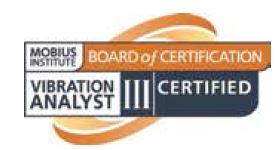WI204 Vibration Analysis ISO Cat 3
The Vibration Analysis Level 3 course is intended for personnel who have at least 2 years vibration analysis experience and a good understanding of vibration theory and terminology. The course provides a comprehensive study of diagnostic measurement techniques, a wide range of analysis techniques, and the steps required to manage a successful condition monitoring program.
Description
The focus of this course is on practical knowledge and understanding of machine knowledge, faults and how to recognize problems in time to plan for an outage and act before catastrophic failure or collateral damage takes place.
Principles of vibration
• Very quick review of fundamentals
• Waveform, spectrum, phase, vectors and orbits
• Signals: transients, pulses, modulation, beating, sum/difference
• Force, response, damping, and stiffness
• Cepstrum analysis
Data acquisition
• Planning routes, test locations and programs
• Signal processing
• Sampling, resolution, Fmax, averaging, windowing,dynamic range, signal-to-noise ratio
• A/D conversion: constant and variable sampling rate
Vibration analysis
• Spectral, time waveform and envelope analysis
Equipment testing and diagnostics
• Impact testing (bump tests)
• Phase analysis
• Transient analysis
• Operating deflection shape analysis
• Introduction to modal analysis
• Cross channel measurements
Fault analysis in detail
• Natural frequencies and resonances
• Imbalance, eccentricity and bent shaft
• Misalignment, cocked bearing and softfoot
• Mechanical looseness
• Rolling element bearing analysis
• Analysis of turbo-machinery and sleeve bearings
• Analysis of AC, DC and variable frequency drives
• Analysis of gears and belt driven machines
• Analysis of pumps, compressors and fans
• Lots of case-studies and exercises for participants
Corrective action
• Balancing and shaft alignment
• Resonance control, isolation and damping
Successful condition monitoring program
• Alarms, reports, management, finances
• Acceptance testing and ISO standards
Key Learning Outcomes
You will come away from this course with a solid understanding of a well designed program, and the reliability centered maintenance approach (with precision balancing, alignment, lubrication and resonance control) will improve the OEE and therefore the bottom line
- Condition Monitoring Technologies: acoustic emission, infrared thermography, oil analysis, wear debris analysis, electric motor testing
- Select the correct measurement location and axis, and collect good, repeatable measurements
- What the Fmax, resolution, averaging and other analyser setting mean, and how to select the optimum settings for a wide variety of machine types
- Analyse vibration spectra, time waveforms, envelope and phase measurements
- Diagnose a range of fault conditions: unbalance, eccentricity, misalignment, bent shaft, cocked bearings, looseness, rolling element bearings faults, journal bearing faults, gearbox faults, resonance, and other conditions
- How to use phase readings, bump tests, impact tests, negative averaging, peakhold averaging, ODS, and modal analysis to determine natural frequencies and visualise machine movement
- How to set alarm limits manually and with statistics
- How to balance and align a machine, and correct a resonance condition
Get Certified!
The training course strictly follows ISO 18436-2 and 18436-3. The optional Certification Exam is provided by Mobius Institute Board of Certification, which is ISO/IEC 17024 accredited in accordance with ISO 18436-1 and ISO 18436-2. Students who meet the experience requirements, complete the course and pass the examination will become certified according to ISO 18436-1 and ISO 18436-2, providing the highest recognised certification available anywhere.
Training Partner
SKF delivers the training in collaboration with the Vibration Institute of Australia.
Recommended Pre-Study
Registered students are given access to the online version of the course via the Mobius Institute Learning Zone™ before the class and for six months after course completion to assist them with converting the course information into
practice.
Who Should Attend
• You have at least two years of vibration analysis experience
• You want to be a leader of the vibration team, or take a leading role in diagnosing faults and making repair recommendations
• You want to understand all data collector options, special test capabilities, all analysis tools and understand the widest range of fault conditions
• You are seeking to become certified to international standards (ISO-18436) by an accredited certification body
• You want to understand all condition monitoring technologies, how and when to apply them
• You want to understand machine dynamics (natural frequencies, resonance, ODS), how to perform resonance testing and how to correct resonance problems
Watch the Category 3 [Advanced] Tour by Jason Tranter from Mobius Institute (click image)

